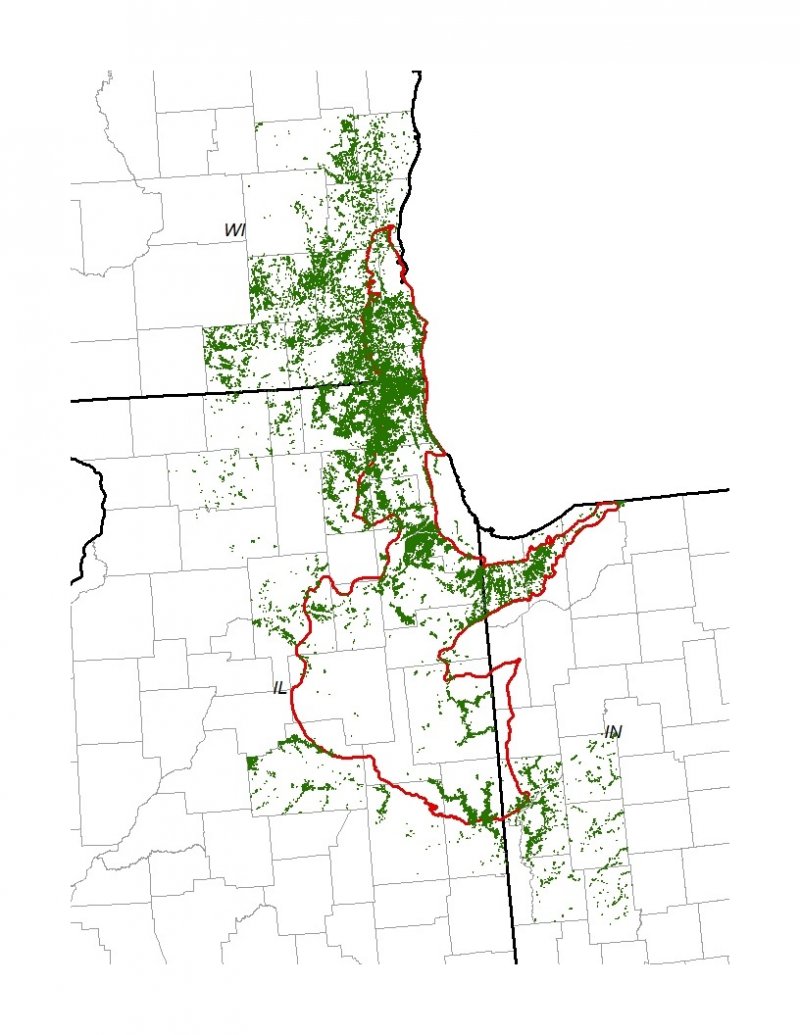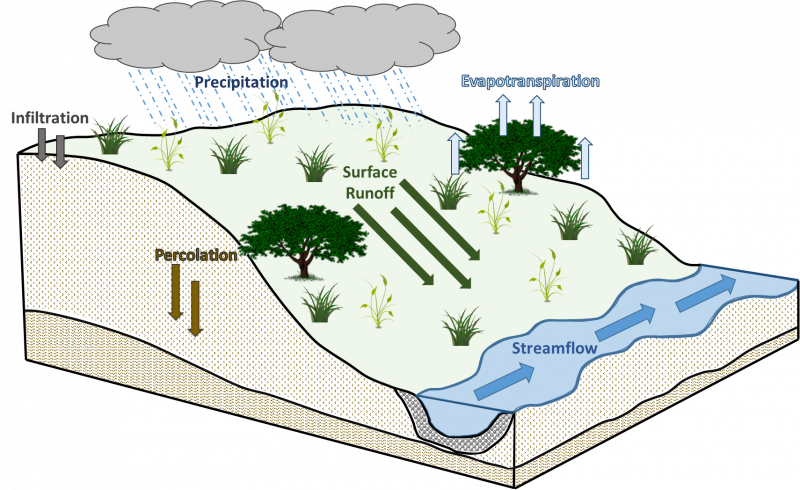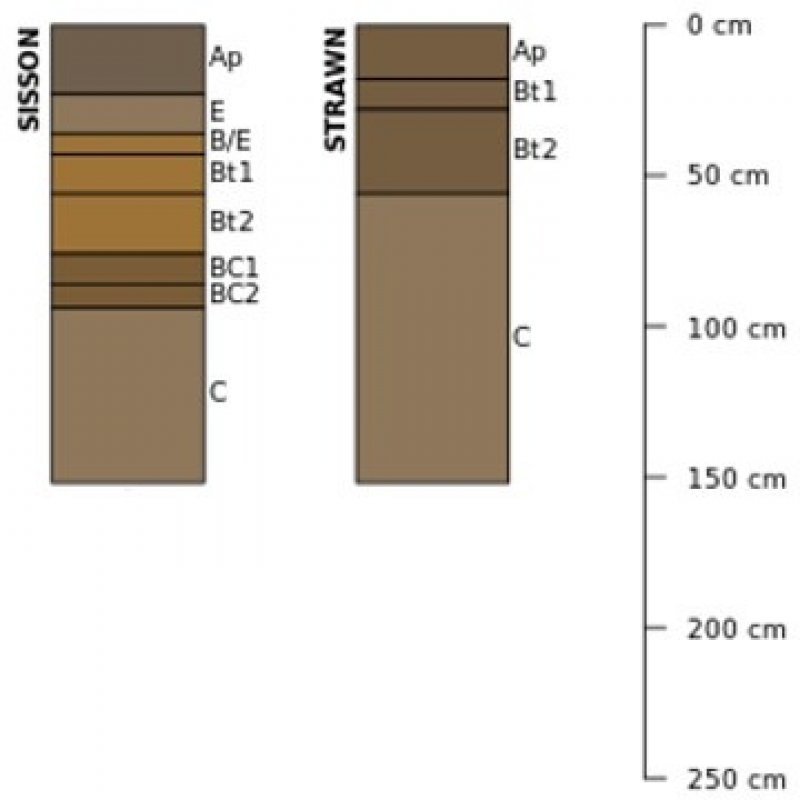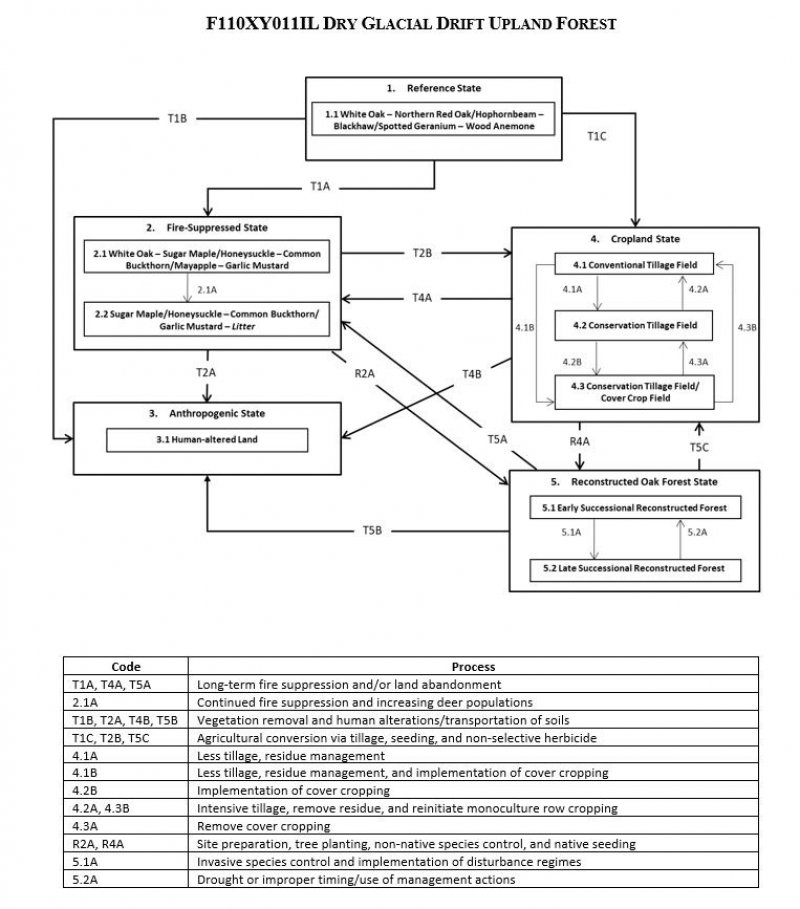Ecological dynamics
The information in this Ecological Site Description, including the state-and-transition model (STM), was developed based on historical data, current field data, professional experience, and a review of the scientific literature. As a result, all possible scenarios or plant species may not be included. Key indicator plant species, disturbances, and ecological processes are described to inform land management decisions.
The MLRA lies within the tallgrass prairie ecosystem of the Midwest, but a variety of environmental and edaphic factors resulted in landscape that historically supported prairies, savannas, forests, and various wetlands. Glacial Drift Upland Forests form an aspect of this vegetative continuum. This ecological site occurs on uplands on well-drained soils. Species characteristic of this ecological site consist of a closed canopy of oaks with shade-tolerant herbaceous vegetation.
Fire is a critical factor that maintains Dry Glacial Drift Upland Forests. Fire typically consisted of low-severity surface fires every 25 to 50 years (LANDFIRE 2009). Ignition sources included summertime lightning strikes from convective storms and bimodal, human ignitions during the spring and fall seasons. Native Americans regularly set fires to improve sight lines for hunting, drive large game, improve grazing and browsing habitat, agricultural clearing, and enhance vital ethnobotanical plants (Barrett 1980; LANDFIRE 2009).
Drought and storm damage have also played a role in shaping this ecological site. The periodic episodes of reduced soil moisture in conjunction with the well drained soils have favored the proliferation of plant species tolerant of such conditions. Drought can also slow the growth of plants and result in dieback of certain species. Damage to trees from wind and ice storms can vary from minor, patchy effects of individual trees to stand effects that temporarily affect community structure and species richness and diversity (Irland 2000; Peterson 2000). When coupled with fire, periods of drought and catastrophic storm damage can greatly delay the establishment and maturation of woody vegetation (Pyne et al. 1996).
Today, Dry Glacial Drift Upland Forests have been reduced as they have been type-converted to agricultural or other human-modified landscape. Remnants that do exist have experienced long-term fire suppression and overbrowsing resulting in significant changes to the forest structure. A return to the historic plant community may not be possible following extensive land modification, but long-term conservation agriculture or forest reconstruction efforts can help to restore some biotic diversity and ecological function. The state-and-transition model that follows provides a detailed description of each state, community phase, pathway, and transition. This model is based on available experimental research, field observations, literature reviews, professional consensus, and interpretations.
State 1
Reference State
The reference plant community is categorized as an oak forest, dominated by deciduous trees and shade-tolerant herbaceous vegetation. The one community phase within the reference state is dependent on recurring fire intervals. The severity and intensity of fire alters species composition, cover, and extent, while regular fire intervals keep the canopy from succeeding to mesophytic, fire-intolerant species. Drought and catastrophic storm damage have more localized impacts in the reference phases, but do contribute to overall species composition, diversity, cover, and productivity.
Community 1.1
White Oak - Northern Red Oak/Hophornbeam - Blackhaw/Spotted Geranium - Wood Anemone
Sites in this reference community phase are a closed canopy forest. White oak and northern red oak are the dominant species, but black oak and shagbark hickory are common canopy associates. Trees are large (21 to 33-inch DBH), and cover is approximately 80 percent (LANDFIRE 2009). Hophornbeam is regularly found in the subcanopy, and tall shrubs – e.g., blackhaw and American hazelnut (Corylus americana Walter) – can be present. The herbaceous layer is nearly continuous with shade-tolerant species such as spotted geranium, wood anemone, largeflower bellwort (Uvularia grandiflora Sm.), Jack in the pulpit (Arisaema triphyllum (L.) Schott), and American hogpeanut (Amphicarpaea bracteata (L.) Fernald). Low-severity surface fires every 25 to 50 years will maintain this community phase.
State 2
Fire-Suppressed State
Fire suppression can transition the reference plant community from an oak forest to an oak-maple mesophytic forest. As the natural fire regime is removed from the landscape, encroachment and dominance by shade-tolerant, fire-intolerant species ensues. This results in a positive feedback loop of mesophication whereby plant community succession continuously creates cool, damp shaded conditions that perpetuate a closed canopy ecosystem (Nowacki and Abrams 2008). Succession to this forested state can occur in as little as 50 years from the last fire (LANDFIRE 2009). Overbrowsing by an unnaturally abundant deer population can also lead to changes in the composition, diversity, and production of the forest. Continuous browsing has been reported to prevent the regeneration of the historic canopy, which is replaced by mid-level and invasive species (Gubanyi et al. 2008; VerCauteren and Hygnstrom 2011). Similarly, herbaceous diversity and composition is also affected by selective browsing pressure (Gubanyi et al. 2008).
Community 2.1
White Oak - Sugar Maple/Honeysuckle - Common Buckthorn/Mayapple - Garlic Mustard
This community phase represents the early stages of long-term fire suppression and overbrowsing. Mature oaks are still present, but the more shade tolerant sugar maple (Acer saccharum Marshall) begins to co-dominate. The tree canopy closes to 100 percent cover and basal area increases (LANDFIRE 2009). Non-native shrubs, such as honeysuckle (Lonicera L.) and common buckthorn (Rhamnus cathartica L.), can rapidly colonize. The herbaceous layer continues to support shade-tolerant species, but diversity is reduced as the fully closed canopy results in favorable conditions mostly by spring ephemerals. Grazing pressure alters species composition, allowing plants such as mayapple to increase as it is commonly avoided by deer (Gubanyi et al. 2008; Rawbinski 2008). Non-native invasive species, such as garlic mustard (Alliaria petiolate (M. Bieb.) Cavara & Grande), can begin to gain a foothold in the understory community as well.
Community 2.2
Sugar Maple/Honeysuckle - Common Buckthorn/Garlic Mustard - Litter
Sites falling into this community phase have a well-established, fire-intolerant canopy dominated by sugar maple. Oak seedlings are virtually absent from the understory due to the lack of available light. Without recurring fire, downed woody debris and leaf litter are frequently encountered on the forest floor.
Pathway 2.1A
Community 2.1 to 2.2
Continued fire suppression and increasing deer populations.
State 3
Anthropogenic State
The anthropogenic state occurs when the reference state is cleared and developed for human use and inhabitation, such as for commercial and housing developments, landfills, parks, golf courses, cemeteries, earthen spoils, etc. The native vegetation has been removed and soils have either been altered in place (e.g. cemeteries) or transported from one location to another (e.g. housing developments). Most of the soils in this state have 50 to 100 cm of overburden on top of the natural soil. This natural material can be determined by observing a buried surface horizon or the unaltered subsoil, till, or lacustrine parent materials. This state is generally considered permanent.
Community 3.1
Human-altered land
Sites in this community phase have had the native plant community removed and soils heavily re-worked in support of human development projects.
State 4
Cropland State
The continuous use of tillage, row-crop planting, and chemicals (i.e., herbicides, fertilizers, etc.) has effectively eliminated the reference community and many of its natural ecological functions in favor of crop production. Corn and soybeans are the dominant crops for the site, and common wheat (Triticum aestivum L.) and alfalfa (Medicago sativa L.) may be rotated periodically. These areas are likely to remain in crop production for the foreseeable future.
Community 4.1
Conventional Tillage Field
Sites in this community phase typically consist of monoculture row-cropping maintained by conventional tillage practices. They are cropped in either continuous corn or corn-soybean rotations. The frequent use of deep tillage, low crop diversity, and bare soil conditions during the non-growing season negatively impacts soil health. Under these practices, soil aggregation is reduced or destroyed, soil organic matter is reduced, erosion and runoff are increased, and infiltration is decreased, which can ultimately lead to undesirable changes in the hydrology of the watershed (Tomer et al. 2005).
Community 4.2
Conservation Tillage Field
This community phase is characterized by rotational crop production that utilizes various conservation tillage methods to promote soil health and reduce erosion. Conservation tillage methods include strip-till, ridge-till, vertical-till, or no-till planting systems. Strip-till keeps seedbed preparation to narrow bands less than one-third the width of the row where crop residue and soil consolidation are left undisturbed in-between seedbed areas. Strip-till planting may be completed in the fall and nutrient application either occurs simultaneously or at the time of planting. Ridge-till uses specialized equipment to create ridges in the seedbed and vegetative residue is left on the surface in between the ridges. Weeds are controlled with herbicides and/or cultivation, seedbed ridges are rebuilt during cultivation, and soils are left undisturbed from harvest to planting. Vertical-till systems employ machinery that lightly tills the soil and cuts up crop residue, mixing some of the residue into the top few inches of the soil while leaving a large portion on the surface. No-till management is the most conservative, disturbing soils only at the time of planting and fertilizer application. Compared to conventional tillage systems, conservation tillage methods can improve soil ecosystem function by reducing soil erosion, increasing organic matter and water availability, improving water quality, and reducing soil compaction.
Community 4.3
Conservation Tillage Field/Alternative Crop Field
This community phase applies conservation tillage methods as described above as well as adds cover crop practices. Cover crops typically include nitrogen-fixing species (e.g., legumes), small grains (e.g., rye, wheat, oats), or forage covers (e.g., turnips, radishes, rapeseed). The addition of cover crops not only adds plant diversity but also promotes soil health by reducing soil erosion, limiting nitrogen leaching, suppressing weeds, increasing soil organic matter, and improving the overall soil ecosystem. In the case of small grain cover crops, surface cover and water infiltration are increased, while forage covers can be used to graze livestock or support local wildlife. Of the three community phases for this state, this phase promotes the greatest soil sustainability and improves ecological functioning within a cropland system.
Pathway 4.1A
Community 4.1 to 4.2
Tillage operations are greatly reduced, crop rotation occurs on a regular interval, and crop residue remains on the soil surface.
Pathway 4.1B
Community 4.1 to 4.3
Tillage operations are greatly reduced or eliminated, crop rotation occurs on a regular interval, crop residue remains on the soil surface, and cover crops are planted following crop harvest.
Pathway 4.2A
Community 4.2 to 4.1
Intensive tillage is utilized, and monoculture row-cropping is established.
Pathway 4.2B
Community 4.2 to 4.3
Cover crops are implemented to minimize soil erosion.
Pathway 4.3B
Community 4.3 to 4.1
Intensive tillage is utilized, cover crop practices are abandoned, monoculture row-cropping is established, and crop rotation is reduced or eliminated.
Pathway 4.3A
Community 4.3 to 4.2
Cover crop practices are abandoned.
State 5
Reconstructed Oak Forest State
The combination of natural and anthropogenic disturbances occurring today has resulted in numerous forest health issues, and restoration back to the historic reference condition may not be possible. Forests are being stressed by non-native diseases and pests, habitat fragmentation, changes in soil conditions, and overabundant deer populations on top of naturally occurring disturbances (severe weather and native pests) (IFDC 2018). However, these habitats provide multiple ecosystem services including carbon sequestration; clean air and water; soil conservation; biodiversity support; wildlife habitat; timber, fiber, and fuel products; as well as a variety of cultural activities (e.g., hiking, camping, hunting) (Millennium Ecosystem Assessment 2005; IFDC 2018). Therefore, conservation of forests and woodlands should still be pursued. Forest reconstructions are an important tool for repairing natural ecological functioning and providing habitat protection for numerous species associated with Dry Glacial Drift Upland Forests. Therefore, ecological restoration should aim to aid the recovery of degraded, damaged, or destroyed ecosystems. A successful restoration will have the ability to structurally and functionally sustain itself, demonstrate resilience to the ranges of stress and disturbance, and create and maintain positive biotic and abiotic interactions (SER 2002). The reconstructed oak forest state is the result of a long-term commitment involving a multi-step, adaptive management process.
Community 5.1
Early Successional Reconstructed Forest
This community phase represents the early community assembly from forest reconstruction. It is highly dependent on the current condition of the site based on past and current land management actions, invasive species, and proximity to land populated with non-native pests and diseases. Therefore, no two sites will have the same early successional composition. Technical forestry assistance should be sought to develop suitable conservation management plans.
Community 5.2
Late Successional Reconstructed Forest
Appropriately timed management practices (e.g., prescribed fire, hazardous fuels management, forest stand improvement, continuing integrated pest management) applied to the early successional community phase can help increase the stand maturity, pushing the site into a late successional community phase over time. A late successional reconstructed forest will have an uneven-aged canopy and a well-developed shrub layer and understory.
Pathway 5.1A
Community 5.1 to 5.2
Application of stand improvement practices in line with a developed management plan.
Pathway 5.2A
Community 5.2 to 5.1
Reconstruction experiences a setback from extreme weather event or improper timing of management actions.
Transition T1A
State 1 to 2
Long-term fire suppression in excess of 50 years transitions the site to the fire-suppressed state (2).
Transition T1B
State 1 to 3
Vegetation removal and human alterations/transportation of soils transitions the site to the anthropogenic state (3).
Transition T1C
State 1 to 4
Tillage, seeding of agricultural crops, and non-selective herbicide transition this site to the cropland state (4).
Transition T2A
State 2 to 3
Vegetation removal and human alterations/transportation of soils transitions the site to the anthropogenic state (3).
Transition T2B
State 2 to 4
Tillage, seeding of agricultural crops, and non-selective herbicide transition this site to the cropland state (4).
Restoration pathway R2A
State 2 to 5
Site preparation, tree planting, invasive species control, seeding native species, and deer management transition this site to the reconstructed oak forest state (5).
Transition T4A
State 4 to 2
Land abandonment transitions the site to the fire-suppressed state (2).
Transition T4B
State 4 to 3
Vegetation removal and human alterations/transportation of soils transitions the site to the anthropogenic state (3).
Restoration pathway R4A
State 4 to 5
Site preparation, tree planting, invasive species control, and seeding native species transition this site to the reconstructed oak forest state (5).
Transition T5A
State 5 to 2
Fire suppression and removal of active management transitions this site to the fire-suppressed state (2).
Transition T5B
State 5 to 3
Vegetation removal and human alterations/transportation of soils transitions the site to the anthropogenic state (3).
Transition T5C
State 5 to 4
Tillage, seeding of agricultural crops, and non-selective herbicide transition this site to the cropland state (4).




